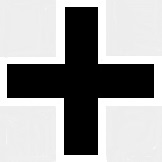Wings of the Great War WW14005 German Albatros D.Va Biplane Fighter - Baron Manfred Von Richthofen, Jagdgeschwader 1
"Open fire only at close range, and then only when the opponent is squarely in your sights."
- Dicta Boelcke
 The Albatros D.V was a German fighter airplane used during World War I. In April 1917, Albatros received an order from the Idflieg (Inspektion der Fliegertruppen) for an improved version of the D.III. The resulting D.V featured a new fuselage with an elliptical cross-section. The flat fuselage sides of the D.III were eliminated. The D.V also used the enlarged rudder of the Ostdeutsche Albatros Werke (OAW) D.III. The upper wing was repositioned 4 inches closer to the fuselage, while the lower wings attached to the fuselage without a fairing. The wings themselves were similar to those of the standard D.III, except for a revised linkage of the aileron cables. Early examples of the D.V featured a large headrest, which was typically removed by pilots because it obstructed the field of view. Aircraft deployed in Palestine used two wing radiators to cope with the warmer climate.
The Albatros D.V was a German fighter airplane used during World War I. In April 1917, Albatros received an order from the Idflieg (Inspektion der Fliegertruppen) for an improved version of the D.III. The resulting D.V featured a new fuselage with an elliptical cross-section. The flat fuselage sides of the D.III were eliminated. The D.V also used the enlarged rudder of the Ostdeutsche Albatros Werke (OAW) D.III. The upper wing was repositioned 4 inches closer to the fuselage, while the lower wings attached to the fuselage without a fairing. The wings themselves were similar to those of the standard D.III, except for a revised linkage of the aileron cables. Early examples of the D.V featured a large headrest, which was typically removed by pilots because it obstructed the field of view. Aircraft deployed in Palestine used two wing radiators to cope with the warmer climate.
The D.V entered service in May 1917 and, like the preceding D.III, immediately began experiencing structural failures of the lower wing. Indeed, anecdotal evidence suggests that the D.V was even more prone to wing failures than the D.III. Furthermore, the D.V offered very little improvement in performance. This caused considerable dismay among frontline pilots. Manfred von Richthofen denounced the D.V as "obsolete" and "ridiculously inferior" to Allied scouts such as the Camel and S.E.5a. Nevertheless, 400 D.Vs were ordered in May and 300 more in July.
In October 1917, production switched to the D.Va, which reverted to the D.III's aileron cable linkage to provide a more positive control response. The wings of the D.III and D.Va were in fact interchangeable. In an effort to resolve continuing problems with wing flutter, the D.Va also featured a metal sleeve to strengthen the lower main spar, as well as a small brace connecting the interplane struts to the leading edge of the lower wing. These modifications increased weight while failing to cure the flutter problem.
While most D.V aircraft were equipped with the 170 hp Mercedes D.IIIa, late D.V and almost all D.Va aircraft used the high-compression 180 hp Mercedes D.IIIa.
The D.Va was the final development of the Albatros D.I family, and the last Albatros fighter to see operational service during World War I. Despite its well-known shortcomings and general obsolescence, Albatros and OAW produced approximately 900 D.V and 1,612 D.Va aircraft. Service numbers peaked in May 1918; 131 D.V aircraft and 928 D.Va were on the Western Front at that time. Numbers declined as production ended and the superlative Fokker D.VII entered service, but the D.Va remained in widespread use until the Armistice.
Pictured here is a 1:72 scale replica of a German Albatros DVa fighter that was piloted by Manfred Von Richthofen.
Pre-order! Ship Date: April 2025.
Dimensions:
Length: 4-inches
Wingspan: 5-inches
Release Date: ?
Historical Account: "Der Rote Baron" - Manfred Albrecht Freiherr von Richthofen (May 2nd, 1892 - April 21st, 1918) was a German pilot who is still regarded today as the "ace of aces". He was a military leader and flying ace and the most successful fighter pilot of World War I, racking up 80 aerial kills.
Richthofen is also known as
"der rote Kampfflieger" ("Red Battle-Flyer") in German; "petit rouge" ("Little Red") or "le Diable Rouge" ("Red Devil") in French, and; the "Red Knight" or the "Red Baron" in the English-speaking world.
The German translation of Red Baron is
"der Rote Baron", and Richthofen is known by this name in Germany as well (although he was rarely referred to as "Baron" in Germany during his lifetime).


